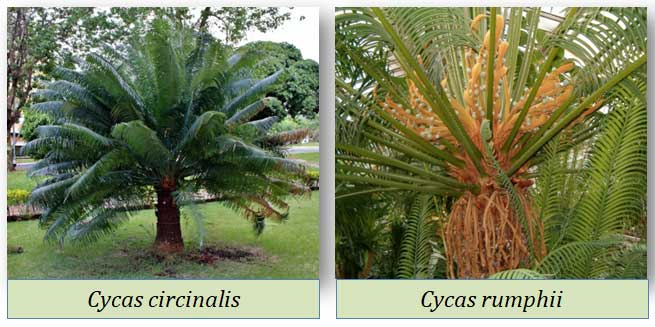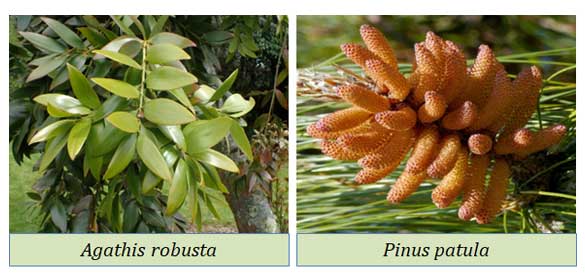Gymnosperms are a group of seed plants that produce naked seeds, which are not protected (enclosed) in the ovary. They are an important Division of the Plant Kingdom and are distributed across the world in various regions. In India, they are found in various habitats, ranging from tropical forests to alpine meadows. In this article, we will discuss the distribution of Gymnosperms in India.
Learn more: General Characteristics of Gymnosperms
Distribution of Gymnosperms in India
Ø India is home to several species of gymnosperms, including Cycads, Conifers and Gnetales.
Ø These species have a wide distribution in India, ranging from the high altitudes of the Himalayan Mountains to the tropical forests of the Western Ghats.
Ø Gymnosperms are also found in the eastern part of the country called the Eastern Ghats.
How many species of Gymnosperms are present in India?
Ø The total number of Gymnosperm species in India is difficult to pinpoint because new ones are constantly being reported and recorded.
Ø As of 2020, it is estimated that there are approximately 80 species of Conifers, 20 species of Cycads and a few species of Gnetales are reported from India.
Ø This highlights the country’s rich Gymnosperm biodiversity and the importance of preserving these unique plant species for future generations.
Distribution of Cycads in India
Ø Cycads (a major group of Gymnosperm including Cycas and its related genera) are one of the oldest groups of seed plants, most of the species are living fossils.
| You may also like NOTES in... | ||
|---|---|---|
| BOTANY | BIOCHEMISTRY | MOL. BIOLOGY |
| ZOOLOGY | MICROBIOLOGY | BIOSTATISTICS |
| ECOLOGY | IMMUNOLOGY | BIOTECHNOLOGY |
| GENETICS | EMBRYOLOGY | PHYSIOLOGY |
| EVOLUTION | BIOPHYSICS | BIOINFORMATICS |
Ø Many of the Cycads are extremely slow-growing plants and they show xerophytic adaptations.
Learn more: Classification of Gymnosperms (K.R. Sporne)
Ø In India, Cycads are found in the tropical and subtropical regions.
Ø They are mostly found in the Western Ghats, where they grow in tropical forests
Ø Some of the most common Cycads found in India are Cycas beddomei and Cycas rumphii, and Cycas circinalis.

Ø The warm and humid climate and rich soil of the Western Ghats provide an ideal growing condition for these Cycas species.
Ø Cycads are also found in other tropical and subtropical regions of India, such as the northeastern states and the Andaman and Nicobar Islands.
Ø In conclusion, Cycads have a restricted distribution in India, with most species found in the tropical and sub-tropical regions of the country. They are primarily found in the Western Ghats.
Learn more: Cycas: Morphology, Anatomy and Reproduction
Distribution of Coniferales in India
Ø Conifers are the dominating taxa of Gymnosperms and are characterized by their cone-shaped growth pattern and needle-like leaves.
Ø Conifers are adapted to grow in high altitude conditions where they can tolerate harsh climatic conditions such as low temperatures, strong winds, and low atmospheric pressure.
Ø In India, Conifers are distributed primarily in the northern and western regions of the country, including the Himalayan Mountains, the northwestern deserts, and the Western Ghats.
Learn more: Classification of Gymnosperms (Chaimberlain)
Ø Approximately 80 species of Conifers have been reported from India.
Ø Himalayan Mountains provide an ideal habitat for several species of conifers
Ø Important Conifer species present in the Himalayan region of India are:
Ø Pinus wallichiana (blue pine): A timber plant, also a source of resin and turpentine
Ø Pinus roxburghii (chir pine): A timber plant
Ø Pinus gerardiana (Chilgoza pine): Nuts are edible

Ø Pinus kesiya (Khasi pine): A timber plant
Ø Pinus patula (Mexican weeping pine): an ornamental species of pine
Ø Abies spectabilis (Himalayan Fir): Native to central Himalaya

Ø Abies webbiana (Nilgiri Fir): Native to Western-ghats
Ø Picea smithiana (East Himalayan Spruce): Present in Eastern Himalayas, a timber plant.

Learn more: Affinities of Gymnosperms
Ø Cedrus deodara (Deodar): A timber plant, source of Cedar wood oil – used as immersion oil in microscopy.
Ø The Western Ghats also provide an ideal habitat for several species of conifers, such as Agathis robusta and Pinus patula.
| You may also like... | ||
|---|---|---|
| NOTES | QUESTION BANK | COMPETITIVE EXAMS. |
| PPTs | UNIVERSITY EXAMS | DIFFERENCE BETWEEN.. |
| MCQs | PLUS ONE BIOLOGY | NEWS & JOBS |
| MOCK TESTS | PLUS TWO BIOLOGY | PRACTICAL |
Distribution of Gnetales in India
Ø Gnetales are a unique group of gymnosperms which includes three genera Gnetum, Ephedra and Welwitschia
Ø Gnetales are characterized by their unique morphological features, such as their morphological similarities with the Angiosperms and the presence of vessels in the xylem.
Ø In India, the Gnetales group is represented by only two genera, Gnetum and Ephedra.
Ø When compared to other groups of Gymnosperms such as Cycads and Coniferales, the diversity of Gnetales is very less.
Ø The genus Gnetum in India is represented by only two species: Gnetum gnemon and Gnetum montanum
Ø Both these species of Gnetum (G. gnemon and G. montanum) are native to Northeast India and it is distributed in Arunachal Pradesh, Assam, Meghalaya, Mizoram and Tripura
Ø Ephedra gerardiana is the only species of Epheda in India which is endemic to northern Sikkim- Eastern Himalaya.

Summary: Gymnosperms are important taxa of the plant kingdom and have a wide distribution in India. They are found in various habitats and environments, ranging from tropical forests to alpine meadows, and play an important role in the ecosystem. The distribution of gymnosperms in India highlights the country’s diverse plant life and the unique habitats that support these plants
<<< Back to Gymnosperms Notes Page
Dear readers
I hope you have enjoyed reading this article. We believe that this article helped you to understand the Distribution of Gymnosperms in India. I would like to take this opportunity to request your COMMENTS on the topics I have covered. Whether you have a suggestion, a question about the topic, or simply want to share your thoughts, I would love to hear from you. Your comments provide me with the opportunity to engage in meaningful discussion and continue to write with the best possible content in Biology.
So, please don’t hesitate to leave a comment below. I appreciate your support and look forward to hearing from you.
Best regards, [Admin, EasyBiologyClass]

upload pdf or ppt form of this topic distribution of gymnosperms and ither topics which are uploaded directly. very useful information
I found important information.. It’s very helpful to me
this is very helpful for me
very well and excellent explanation of topic